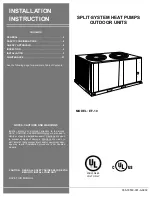
035-18550-001-A-0902
6
Unitary Products Group
3.
The outdoor unit should not be installed beneath
windows or between structures where normal oper-
ating sounds may be objectionable.
4.
All units require certain clearances for proper oper-
ation and service. Refer to General Installation
Form 55.70-N1 for additional guidelines.
On either roof top or ground level installations, rubber
padding can be applied between the base rails and
their supports to lessen any transmission of vibration.
ROOF-TOP LOCATIONS
Be careful not to damage the roof. Consult the building
contractor or architect if the roof is bonded. Choose a
location with adequate structural strength to support
the unit.
The unit must be mounted on solid level supports. The
supports can be channel iron beams or wooden beams
treated to reduce deterioration.
A minimum of two (2) beams are required to support
each unit. The beams should: (1) Be positioned per-
pendicular to the roof joists. (2) Extend beyond the
dimensions of the unit to distribute the load on the roof,
(3) Be capable of adequately supporting the entire unit
weight. Refer to Figure 1 and Table 1 for load distribu-
tion and weights.
These beams can usually be set directly on the roof.
Flashing is not required.
NOTE:
On bonded roofs, check for special installation
requirements.
GROUND LEVEL LOCATIONS
The units must be installed on a substantial base that
will not settle. Any strain on the refrigerant lines may
cause a refrigerant leak.
A one-piece concrete slab with footers that extend
below the frost line is recommended. The slab should
not be tied to the building foundation because noise
and vibration will telegraph into the building.
A unit can also be supported by concrete piers. These
piers should: (1) extend below the frost line, (2) be
located under the unit's four corners and (3) be sized to
carry the entire unit weight. Refer to Figure 1 and Table
1 for the center of gravity and unit weight.
A gravel bed or some other means of handling the con-
densate that will drop from the underside of the unit coil
during the heating and defrost cycles may have to be
provided.
RIGGING AND HANDLING
Exercise care when moving the unit. Do not remove
any packaging until the unit is near the place of installa-
tion.
Rig the unit by attaching nylon straps with hooks to the
lifting holes provided in the base rails. Spreaders,
whose length exceeds the largest dimension across
the unit, MUST be used across the top of the unit if the
The outdoor unit should not be installed in an
area where mud and/or ice could cause per-
sonal injury. Remember that condensate will
drip from the underside of the unit coils during
heat and defrost cycles and that this conden-
sate will freeze when the temperature of the
outdoor air is below 32°F.
Care should be taken to protect the unit from
tampering and unauthorized persons from
injury. Screws on access panels will prevent
casual tampering. Additional safety precau-
tions such as fences around the unit or locking
devices on the panels may be advisable.
Check local authorities for safety regulations.
FIGURE 1 - CENTER OF GRAVITY
Unit
Dim. (In.)
A
B
C
D
10 Ton
76-7/8
39-7/8
38-7/8
16





















